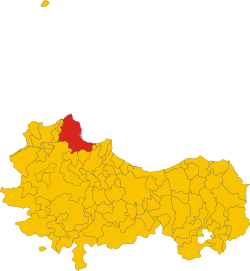Palermo
Palermu (Sicilian) | |
|---|---|
| Comune di Palermo | |
 The municipality of Palermo within the Metropolitan City of Palermo | |
| Coordinates: 38°06′40″N 13°21′06″E / 38.11111°N 13.35167°E | |
| Country | Italy |
| Region | Sicily |
| Metropolitan city | Palermo (PA) |
| Founded | 736 BC |
| Government | |
| • Mayor | Roberto Lagalla (UDC) |
| Area | |
• Total | 158.9 km2 (61.4 sq mi) |
| Elevation | 14 m (46 ft) |
| Population (31 January 2013)[2] | |
• Total | 676,118 (city) 1,300,000 (metro) |
| Demonym(s) | Palermitano Panormito Palermitan (English) |
| Time zone | UTC+1 (CET) |
| • Summer (DST) | UTC+2 (CEST) |
| Postal code | 90100 |
| Dialing code | 091 |
| ISTAT code | 082053 |
| Patron saint | Saint Rosalia, Saint Agata, Saint Oliva and Saint Benedict the Moor |
| Saint day | 14 July |
| Website | Official website |
Palermo (/pəˈlɛərmoʊ, -ˈlɜːr-/ pə-LAIR-moh, -LUR-;[3] Italian: [paˈlɛrmo] ; Sicilian: Palermu, locally also Paliemmu [paˈljɛmmʊ] or Palèimmu)[4][a] is a city in southern Italy, the capital of both the autonomous region of Sicily and the Metropolitan City of Palermo, the city's surrounding metropolitan province. The city is noted for its history, culture, architecture and gastronomy, playing an important role throughout much of its existence; it is over 2,700 years old. Palermo is in the northwest of the island of Sicily, by the Gulf of Palermo in the Tyrrhenian Sea.
The city was founded in 734 BC by the Phoenicians as Sis ("flower"). Palermo then became a possession of Carthage. Two Greek colonies were established, known collectively as Panormos; the Carthaginians used this name on their coins after the 5th century BC. As Panormus, the town became part of the Roman Republic and Empire for over a thousand years. From 831 to 1072 the city was under Arab rule in the Emirate of Sicily when the city became the capital of Sicily for the first time. During this time the city was known as Balarm.[5] Following the Norman conquest, Palermo became the capital of a new kingdom, the Kingdom of Sicily, that lasted from 1130 to 1816.[6]
The population of Palermo urban area is estimated by Eurostat to be 855,285, while its metropolitan area is the fifth most populated in Italy with around 1.2 million people. In the central area, the city has a population of around 676,000 people. The inhabitants are known as Palermitani or, poetically, panormiti. The languages spoken by its inhabitants are the Italian language and the Palermitano dialect of the Sicilian language.
Palermo is Sicily's cultural, economic and tourism capital. It is a city rich in history, culture, art, music and food. Numerous tourists are attracted to the city for its appealing Mediterranean climate, its renowned gastronomy[citation needed] and restaurants, its Romanesque, Gothic, Baroque[7] and Art Nouveau[8] churches, palaces and buildings, and its nightlife and music.[9] Palermo is the main Sicilian industrial and commercial center: the main industrial sectors include tourism, services, commerce and agriculture.[10] Palermo has an international airport and a significant underground economy.[citation needed] For cultural, artistic and economic reasons, Palermo is one of the largest cities in the Mediterranean and is now among the top tourist destinations in both Italy and Europe. It is the main seat of the UNESCO World Heritage Site Arab-Norman Palermo and the Cathedral Churches of Cefalù and Monreale. The city is also going through careful redevelopment, preparing to become one of the major cities of the Euro-Mediterranean area.[11]
Roman Catholicism is highly important in Palermitan culture. The Patron Saint of Palermo is Santa Rosalia whose Feast Day is celebrated on 15 July. The area attracts significant numbers of tourists each year and is widely known for its colourful fruit, vegetable and fish markets at the heart of Palermo, known as Vucciria, Ballarò and Capo.[12]
- ^ "Superficie di Comuni Province e Regioni italiane al 9 ottobre 2011". Italian National Institute of Statistics. Retrieved 16 March 2019.
- ^ "Popolazione Residente al 1° Gennaio 2018". Italian National Institute of Statistics. Retrieved 16 March 2019.
- ^ Wells, John C. (2008). Longman Pronunciation Dictionary (3rd ed.). Longman. ISBN 978-1-4058-8118-0.
- ^ Cappello, Teresa; Tagliavini, Carlo (1981). Dizionario degli etnici e dei toponimi italiani (in Italian). Bologna: Pàtron. p. 387. ICCU IT\ICCU\UMC\0979712.
- ^ Trabia, Carlo. "Discovering the Kalsa". Best of Sicily. Archived from the original on 6 May 2018. Retrieved 26 December 2017.
- ^ "Palermo | History, Attractions, & Facts". Encyclopedia Britannica. Archived from the original on 8 March 2021. Retrieved 3 March 2021.
- ^ Anthony Blunt, Sicilian Baroque.
- ^ "Palermo". Art Nouveau European Route : Cities. Archived from the original on 27 December 2013. Retrieved 8 November 2019.
- ^ "Travel: Palermo, Sicily". Sicilian Culture. 9 March 2002. Archived from the original on 28 November 2010. Retrieved 20 April 2010.
- ^ "Sicily". europa.eu. 23 July 2010. Archived from the original on 2 August 2017. Retrieved 1 August 2017.
- ^ "Palermo – Culturforum – Italian language courses In Palermo". Archived from the original on 5 August 2019. Retrieved 5 August 2019.
- ^ Pergament, Danielle (8 January 2008). "In Palermo, Life Vibrates in a Fading Market". NYTimes.com. Archived from the original on 6 October 2010. Retrieved 21 May 2010.
Cite error: There are <ref group=lower-alpha> tags or {{efn}} templates on this page, but the references will not show without a {{reflist|group=lower-alpha}} template or {{notelist}} template (see the help page).











